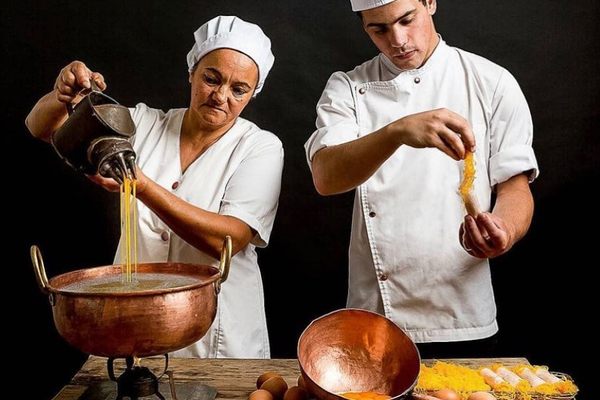The Truth Behind the Girl Scout Cookie Graveyard
Even popular cookies can end up permanently cut from the roster.
THIS ARTICLE IS ADAPTED FROM THE MARCH 16, 2024, EDITION OF GASTRO OBSCURA’S FAVORITE THINGS NEWSLETTER. YOU CAN SIGN UP HERE.
It’s Girl Scout cookie season, which I consider a holiday in and of itself. Every local Girl Scout council has their own cookie schedule, so if you want to buy any, now’s the time to look up if they are being sold near you.
But there’s some Girl Scout cookies that money can’t buy. Namely, the 60-plus discontinued Girl Scout cookies from decades past. Remember Savannah Smiles? How about Animal Treasures? Did you get your hands on a box of Raspberry Rallies in 2023?
Last week, I called up Karen Schillings, a council historian for the Girl Scouts of Greater Chicago and Northwest Indiana to chat about both long-gone and recently departed cookies.
In the Beginning

Girl Scouts have peddled cookies for more than a century now. The first Girl Scout cookie didn’t come from a box. Instead, Girl Scouts baked the treats themselves, and sold them to raise money for camping and other activities. In 1922, a Girl Scout magazine published a sugar cookie recipe for members to make themselves.
By the 1930s, the Girl Scouts turned to commercial bakers. “It got to the point where the girls couldn’t keep up with the demand for the cookies. So that’s when the National [the Girl Scout National Council] decided it would be okay for the councils to make contracts with local bakers to bake the cookies,” says Schillings.
The cookies stayed fairly simple for a while, and, Schillings notes, as many as 29 bakeries at one point were producing them for the Scouts. Options included buttery shortbread, sandwich cookies, and, in 1939, an ancestor of the Thin Mint, called the Cooky-Mint.
A Tale of Two Bakeries

By the 1990s, only two bakeries were licensed to make the cookies: ABC Bakers and Little Brownie Bakers.
Schillings, who led a Girl Scout council as president for six years, notes that each council decides which bakery to source their cookies from, based on the price per box and the projected number of boxes needed. “Naturally, if they can sell more cookies, they’re going to get a cheaper price for it,” she says.
Do you have a box of Girl Scout cookies near you, right now? Flip it over and look at the bottom flap to find the company that made your cookies. Interestingly, the bakers use different ingredients and methods to make their cookies, resulting in differences in both taste and appearance. Of course, there are passionate arguments online about which bakery is better.
There are also some naming differences. Both ABC Bakers and Little Brownie Bakers make chocolate-covered mint cookies called Thin Mints and shortbread cookies called Trefoils. Both companies make peanut-butter-and-chocolate cookies, but ABC Bakers calls theirs Peanut Butter Patties, and Little Brownie calls theirs Tagalongs. Same goes for the coconut-chocolate cookies (Caramel deLites versus Samoas) and peanut butter sandwich cookies (Peanut Butter Sandwiches versus Do-si-dos).
Schilling notes that these five cookies are the mainstays of the Girl Scouts’ lineup, and will likely not change any time soon. They clearly have staying power: All were added to the roster in either 1974 or 1976.
Past those five cookies, though, yawns an abyss filled with cookie ghosts. This is the Girl Scout cookie graveyard.
Remembrance of Cookies Past

Usually, says Schillings, there are eight or nine different cookies available for Girl Scouts to sell every year. “The cookie companies will pitch the new cookies to the National organization, and then if the National organization picks it up, then that baker bakes that particular cookie for all of the councils,” she explains.
As a former Girl Scout myself, I remember selling the enormous Animal Treasures cookies, shortbread squares stamped with images of endangered animals and dipped in chocolate. These were only available, though, between the years of 1999 and 2005.
Then there’s the deeply mourned Savannah Smiles, a powdered sugar–dusted lemon cookie shaped like a half-moon. Those lasted from 2011 to 2019. Copycat recipes abound online, and there’s even a petition to bring them back; one of many for lost Girl Scout cookie flavors.
So why would the Girl Scouts stop selling beloved cookies? Often, says Schillings, the decision comes from Little Brownie or ABC, who are the ones coming up with the recipes in the first place. It also depends on the price of ingredients and the cost of producing certain cookies. Obviously, if a cookie doesn’t sell enough boxes, it’s cut from the roster.
One of Schillings’s responsibilities as a Girl Scout council historian is to research cookie history, so she has certain insights about which cookies succeed and which don’t. “We’ve never had a cinnamon cookie that lasted long,” she says. Historically, sugar-free cookies never stay on the line-up either. “When you buy a Girl Scout cookie, you probably are not thinking about the calories involved,” she adds.
Certain flavors are always popular. “It’s come in a lot of different names and different configurations, but we’ve almost always had a lemon cookie,” says Schillings. While sugar-free cookies didn’t work out, Schillings notes that the Girl Scouts have, of late, sold gluten-free cookies in limited quantities. This year, for example, Little Brownie produced the gluten-free Toffee-tastic cookie, while ABC offered a gluten-free Caramel Chocolate Chip.
How the Cookie Crumbles

Sometimes, limited quantities of cookies can lead to disaster. In 2023, there was what Schillings calls “the Raspberry Rally fiasco.” Raspberry Rallies were Thin Mint–like wafers, but with a raspberry cookie under the chocolate. They were available only online due to limited quantities, but Little Brownie Bakers struggled to source ingredients, says Schillings. “It ended up that they couldn’t fulfill the orders for them.” The cookies, though, had become a cult hit, leading to some resellers asking upwards of $100 a box for the cookies online.
Sometimes, the cuts from the cookie roster can seem almost arbitrary, especially when they’ve been available for a decade or more (such as the Thanks-A-Lot chocolate-dipped shortbread, which were sold from 2006 to 2021). But Schillings notes that new cookies help create buzz for the yearly cookie sales. “People are always interested in seeing what the new flavors are and trying them out. So I think that’s why they switch them out, too, just because it generates a little excitement in the customers.”
Don’t worry. Thin Mints aren’t going anywhere. Keeping a slate of beloved cookies around while adding limited-time options is just good business. And that’s what the Girl Scout cookie sales are all about. “The cookie sale is the way that our girls become entrepreneurs. They learn how to run a business. They learn how to take care of money,” Schillings says. “It’s not that all our girls are going to end up being entrepreneurs in the future, but at least it gives them an idea of what it’s like to manage all of these things at once.”
“And I think that’s one of the best parts of the cookie sale,” she says. “It’s not just that the girls earn money. They earn life skills.”
Gastro Obscura covers the world’s most wondrous food and drink.
Sign up for our regular newsletter.


































Follow us on Twitter to get the latest on the world's hidden wonders.
Like us on Facebook to get the latest on the world's hidden wonders.
Follow us on Twitter Like us on Facebook